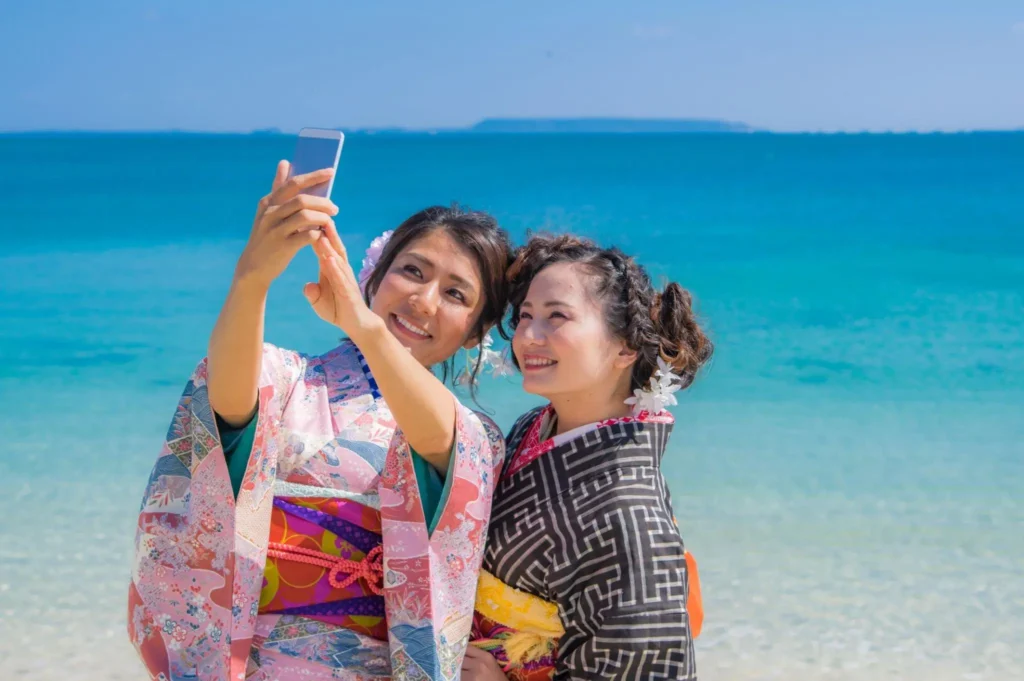What to Wear in Japan in Summer: Essential Clothing Tips for July and August in Your Japan Travel

Traveling to Japan is more challenging than one thinks. The most important thing is to decide what to wear and what clothing items should be kept while packing for the Japan tour, especially in summer. Japan has hot and humid weather in July and August, so dressing up or down is important for comfort.
Wear light, breathable clothes like cotton shirts, tanks, and shorts. Pack loose-fitting, lightweight garments so you can move around and not sweat too much. Here, we have come up with a complete guide about what to wear in Japan in summer. You will get all the information about essential clothing tips for July and August in your Japan travel.

Headline
Summer in Japan
Summer in Japan is a season of joy and celebration. Its colorful festivals, spectacular fireworks displays, and warm and humid weather characterize it. Obon is one of the most celebrated summer festivals in Japan. It marks the return of ancestors’ spirits to their families. Colorful parades, dances, and music mark celebrations. The sky is filled with vibrant colors. Japan temperature in these days ranges from 21°C (70°F) to 32°C (90°F). Japanese summer days are not blistering hot.
Fireworks displays are also a major highlight of summer and can be seen nationwide. Japan in summer provides an opportunity to explore the country’s natural beauty by hiking in the mountains and relaxing on the beaches. It is one of the most amazing weather in Japan for visitors.
It is possible to experience a slight chill in the mornings and evenings or on rainy days during June. It is strongly suggested to wear a lightweight cardigan over one’s T-shirt during this time of the year. It is important to note that extreme heat is unavoidable in Japan, and a simple t-shirt or one-piece garment is sufficient for the summer months.
Weather in Japan in July
July is particularly hot and humid in Japan, with temperatures typically ranging from 25°C to 30°C. The high level of humidity can make the temperature feel even higher, especially in the capital cities. Additionally, this month marks the beginning of the tsuyu (rainfall season) in many areas of Japan.
It is characterized by heavy rainfall and frequent thunderstorms. Despite the difficult weather, July is a popular festival and event season in Japan. It allows visitors to witness the country’s vibrant culture amid the heat and rain.
Weather in Japan in August
Due to summer and the Pacific High-pressure System, August is a hot and humid month in Japan. In Tokyo and Osaka, temperatures typically range from 30 to 35 degrees Celsius. However, in heatwaves, temperatures may exceed 35 degrees Celsius.
August is also associated with frequent rainfall and occasionally typhoons. It can cause heavy rain, gusty winds, and even flooding. Therefore, it is recommended that visitors dress appropriately and stay informed of weather forecasts to ensure a pleasant and safe trip to Japan.
What to Wear in Japan in Summer? In July and August
The weather in Japan can vary depending on where you’re going – north, south, or east. It’s usually chillier in the north, like Hokkaido or Tohoku, but in the south, it’s generally warmer, like Okinawa or Kyushu. Plus, the heat can be more intense in cities than in the countryside.
Summer in Japan can be hot and muggy, no matter whether you are going in July or August. So make sure you dress in light, breathable clothes. Men can wear light cotton shirts and linen pants, while women can wear loose-fitting tops and dresses or skirts. Choose light colors to catch the sun’s rays, and steer clear of dark shades that let in too much heat. It is better to ensure you have packed a wide-brim hat and sunglasses to avoid the sun’s glare.
Comfortable Pants And Loose Tops
When planning to travel to Japan in summer, it’s important to consider the weather and culture. Summer is the hottest season. It can get pretty hot and humid during the summer. Here are tips on what to wear in Japan during this time. So it’s best to wear lightweight, breathable clothes.
Wear comfy pants made of something like linen or cotton. It is suggested not to wear jeans or any attire that won’t let your skin breathe. It would help if you preferred to wear loose tops like T-shirts or flowy blouses to keep you cool in the sweaty season. It will give you a stylish look in a hot summer.
Also, remember the traditional Japanese way of wearing clothes, especially when visiting temples or other holy places. You have to dress modestly and don’t show too much skin.
Because Japanese people don’t like this, finally, check out the weather forecast before you leave to ensure you’re ready for whatever the weather throws. It will help you to decide what to wear in summer. Some suggestions are;
Middle for July and August: Linen checked shirts (2,990 yen + tax), Crew-neck T-shirts (1,000 yen + tax), and Cotton linen easy pants (2,990 yen + tax).
Thin Outwear
When planning to visit Japan in the summer, always remember thin outerwear. Thin outwear is a great option for keeping cool in the heat, as it allows for air circulation. Japanese clothing is renowned for its light and breathable materials, and the Yukata is a popular summer kimono among locals and tourists.
It is crafted from light cotton fabric, making it ideal for the summer months. Men can choose between a traditional Yukata. They can also wear shorts with a lightweight shirt, especially when visiting the northern part of Japan.
Women can opt for a Yukata, usually paired with an Obi Belt and Geta Sandals, or a breezy Summer Dress. Men and women can also opt for T-shirts, Shorts, and Flowy Skirts. Such types of tops are usually saved for late-night attire.
Additionally, sunscreen, a Hat, and Sunglasses are essential to protect against the sun’s rays. All in all, the ideal clothing for summer in Japan should be lightweight and breathable, allowing you to take in the sights while remaining comfortable in the heat.
Suitable Shoes To Wear in Japan in The Summer
Japan is renowned for its advanced toilets, and the rules of footwear etiquette also extend to the bathroom. It is customary to take off one’s shoes when entering public areas. Plastic slippers are placed outside the door for the user to wear while in the restrooms.
This no-shoe policy applies to occasional public areas, such as restaurants, traditional office settings, public baths, temples, and educational institutions. Generally, public spaces that necessitate the removal of the shoes will have public slippers. If the idea of wearing an old communal pair of slippers is not appealing, bringing one of your own is recommended.
Slip-on Shoes
When you plan to go to Japan, wearing slip-on shoes is a good idea. The summer months in Japan are characterized by extreme heat and humidity, making it essential to wear shoes that are light in weight and breathable.
Sandals or sneakers are comfortable and convenient to wear in summer vacations. They can be easily slipped on and off when entering a museum, temple, or shrine, where shoes must be removed.
Additionally, slip-ons provide good ventilation to allow the feet to breathe. It also reduces the excessive sweating. They can be worn with various outfits, from vibrant Tokyo streets to traditional tea houses in Kyoto.
They are cool and comfortable, making them an ideal choice for a stylish and comfortable summer tour with traditional Japanese clothing. But they are not suitable for the rainy season in Japan.
Slippers
When visiting Japan in the summer, it is important to wear suitable shoes that provide comfort and adhere to cultural norms. One aspect to consider is respecting the local customs when visiting shrines. Many shrines in Japan request visitors to remove their shoes before entering.
In the Japanese tradition, not removing shoes is appearing disrespectful while visiting shrines and temples. These are the best walking shoes in Japan’s summer.
When visiting a shrine, it is customary to wear slippers provided by the shrine. This not only helps to keep the feet clean but also demonstrates respect for the local customs. To accompany the slippers, a pair of socks should be brought; some shrines may require visitors to wear socks for sanitary reasons.
By wearing appropriate footwear and adhering to the local customs, visitors can fully immerse themselves in the Japanese culture while visiting the renowned shrines in the summer months.
What To Wear in Japan In Autumn?
If you plan a trip to Japan in October, you may wonder what to wear. Autumn in Japan is a season of beauty and transition. Temperatures begin dropping, and the leaves turn red to orange to yellow. When selecting clothing for this season, it is important to know the changing weather conditions.
Layer with a lightweight jacket, cardigan, long-sleeve shirt, or light sweater. A scarf should also be brought to keep warm in the winter. For bottoms, be sure to bring along jeans or trousers while exploring Japan this season.
Wear comfortable walking or boots if you plan to explore the various autumn foliage spots. An umbrella is a must-have for autumn in Japan, as unpredictable rain showers may occur.
Overall, wearing layers and being ready for the changing weather will guarantee a comfortable and fashionable autumn in Japan.
It does not rain every day in cities like Tokyo. The weather is usually overcast and dreary. During this time, the average daytime temperature in Tokyo is about 22℃, or 71.6℉. So you can wear light dresses here this season.
What To Wear In Japan During The Winter Months?
The winter season in Japan is characterized by cold and snowy weather, particularly in the northern areas. Wear a layer of clothing to keep warm to ensure a comfortable and stylish winter wardrobe.
Thermal or woolen underwear should be worn under a long-sleeve shirt, followed by a sweater, coat, or jacket. A down or padded jacket is recommended to insulate against the cold winds.
Thick socks, waterproof shoes, and boots should be worn to protect the feet from snow and ice. A hat, scarf, and gloves should be worn to keep the extremities warm. Dark colors are usually a safe bet. However, some pops of color can be added to brighten the winter landscape.
For added comfort, a small hand warmer should be carried. Finally, the weather forecast should be consulted to plan the outfit accordingly.
Japan Travel essentials
If you’re planning a trip to Japan, here are a few things to remember:
- It’s important to remember that Japan is a unique country with its customs and traditions. Be respectful of these, like bowing when you greet someone and taking off your shoes when you enter certain places.
- Make sure you know how to get around. Japan has a great public transportation system, especially bullet trains, but it’s also important to familiarize yourself with the local signs and schedules.
- Make sure you pack the right clothes for the season. Temperatures can vary a lot, especially in the north.
- Feel free to try new foods; there’s something for everyone.
What should you avoid wearing in Japan?
Japan is a nation that prides itself on its sophistication and organization. When you’re in Japan, it’s important to stay on top of the culture and make sure you dress right. Here are a few things to remember to ensure you’re respectful and don’t offend anyone.
Don’t wear anything too revealing or tight, as this could be disrespectful. Don’t wear shoes that need to be laced up or tied, as they can be seen as casual and unsuitable for formal events. And don’t wear a T-shirt with a big logo or slogan in English, as it could be seen as offensive.
Also, don’t wear your shoes when entering someone’s house or some more traditional places like temples and ryokan. Knowing these tips will help you have a more relaxed and enjoyable time in Japan.
Conclusion
In conclusion, what to wear in Japan in July and August? July and August are the hottest months of the year in Japan, so it’s important to dress accordingly to cope with the high temperatures and humidity. Wearing lightweight and breathable clothes is key to staying comfortable in the hot weather.
Wearing loose-fitting clothing made of natural cotton or linen is recommended as it allows air circulation and better absorbs sweat. Light-colored clothing is also recommended as it absorbs heat better than darker shades.
Packing a hat, sunglasses, and sunscreen to protect your skin from the harsh sun rays is also a good idea. Don’t wear closed shoes in Japan, as it’s too hot for your feet. Instead, opt for a pair of sandals or flip-flops for better ventilation.
Japan may be known for its trend-led streets, but it’s also important to remember that comfort is more important than fashion in the summer months. Following the essential clothing tips below, you can enjoy your Japan travel without sacrificing comfort.





